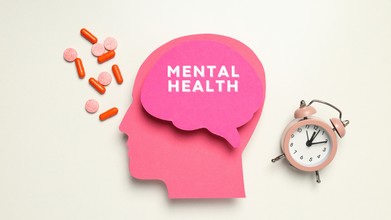- Health Conditions A-Z
- Health & Wellness
- Nutrition
- Fitness
- Health News
- Ayurveda
- Videos
- Medicine A-Z
- Parenting
- Web Stories
World Mental Health Day: Can Depression Or Anxiety Increase Your Risk of Heart Disease? Experts Explain

Credits: Canva
October 10 marks World Mental Health Day, a day that brings global attention to one of the most discussed health concerns today: depression and anxiety. But could these mental health challenges also affect physical health, particularly the heart? Depression and heart disease rank among the most disabling conditions worldwide. Both are widespread and often occur together in the same individual. So, can mental health issues actually worsen heart health?
Can Depression Or Anxiety Lead To Heart Issues?
The link between heart disease and mental health is complex and goes both ways. Conditions like coronary artery disease, heart failure, and high blood pressure can increase the likelihood of developing mental health issues such as depression and anxiety. Conversely, those living with mental health disorders are also more susceptible to heart problems.
According to the Centers for Disease Control and Prevention (CDC), some of the most commonly studied mental health conditions connected to heart disease or related risk factors include:
- Mood Disorders: Conditions such as major depression or bipolar disorder can affect emotional and mental well-being almost daily, impacting overall health.
- Anxiety Disorders: Individuals experience intense fear or dread in response to situations or objects. Anxiety disorders include generalized anxiety, social anxiety, panic disorders, and phobias.
- Post-Traumatic Stress Disorder (PTSD): PTSD can develop after traumatic experiences such as accidents, natural disasters, or violent events.
- Chronic Stress: Persistent emotional stress can trigger predictable biochemical, physiological, and behavioral changes over time, affecting long-term health.
Connection Between Heart Disease And Mental Health Issues
A growing body of research indicates that mental health can influence risk factors for heart disease both before and during treatment for a mental health condition. These effects occur through biological pathways and indirectly through risky health behaviors, according to the CDC.
Long-term depression, anxiety, stress, and PTSD can cause physiological changes such as increased heart rate and blood pressure, reduced blood flow to the heart, and elevated cortisol levels. Over time, these changes may contribute to calcium buildup in arteries, metabolic disorders, and heart disease.
Studies also show that mental health conditions can develop after a cardiac event like heart failure, stroke, or heart attack. These disorders may be triggered by pain, fear of death or disability, and the financial or emotional strain associated with recovery.
Moreover, conditions such as anxiety and depression can make it harder for individuals to maintain healthy behaviors. People may be more likely to smoke, lead a sedentary lifestyle, or neglect prescribed medications because mental health challenges reduce coping strategies for stress and make healthy choices more difficult.
How To Tackle Mental Health And Heart Diseases?
People handle challenging situations in different ways. Some react strongly, while others stay relatively calm. The good news is that you can reduce how stress affects your body. Start by recognizing the situations that trigger stress, and work on managing both your mental and physical responses.
To help manage stress and protect your heart, Dr. Prateek Chaudhary, Sr. Consultant – Interventional Cardiology at Asian Hospital, recommends the following tips:
- Exercise regularly: Physical activity helps counteract the harmful effects of stress, depression, and anxiety.
- Aim for consistency: Try to get at least 150 minutes of moderate-intensity exercise each week for optimal heart health.
- Protect mental and heart health: Regular exercise can also lower the risk of depression, which itself is a risk factor for heart disease.
Disclaimer: Mental health is important, and if you are experiencing symptoms of depression, anxiety, or stress, you should consult a qualified healthcare professional for guidance and support.
With New CDC Guidance, Are Pregnant Women Advised to Get the COVID Vaccine?

Credits: Canva
Pregnant women covid vaccine: Pregnant women hoping to get a COVID shot could face more difficulty accessing it this year. Although leading medical organizations still advise that pregnant women receive the vaccine to protect both themselves and their babies, recent moves by federal health authorities have caused uncertainty over whether the shots are essential during pregnancy.
For those unversed, in May, the Centers for Disease Control and Prevention removed its official recommendation for pregnant women to receive the vaccine. This week, the CDC rolled out new COVID-19 vaccine guidance, but it does not clearly spell out what pregnant women should do.
Dr. Neil Silverman, professor of clinical obstetrics and gynecology at the David Geffen School of Medicine at UCLA, calls this episode another chapter in the ongoing "battle over public health." With respiratory virus season approaching, experts stress the need to reaffirm that COVID-19 vaccines are both safe and necessary during pregnancy. Here’s what you should know.
Should Pregnant Women Get a COVID-19 Vaccine?
Generally, yes, experts say. Current guidance from ACOG and the Society for Maternal-Fetal Medicine recommends that patients receive a COVID-19 vaccine at some point while trying to conceive, during pregnancy, or while breastfeeding.
The vaccine is considered safe for pregnant women and can greatly reduce the risk of severe COVID-19 complications, according to the data. This is particularly important because pregnancy increases the risk of serious COVID-19 outcomes, including hospitalization, pregnancy loss, and stillbirth.
Even a mild COVID infection can cause fever or discomfort, which may lead to complications, Brandt explains.
The recommendations also note that vaccination during pregnancy provides protection for newborns in the first few months of life, when they are too young to be vaccinated themselves.
What Does the CDC Say About the COVID Vaccine in Pregnancy?
Earlier, the CDC’s guidance for COVID-19 vaccination in pregnancy aligned with professional medical groups. That changed when Health and Human Services Secretary Robert F. Kennedy Jr. bypassed the standard review process and announced the CDC would no longer recommend routine COVID vaccination for "healthy pregnant women," NBC News reported.
In September, the CDC’s advisory panel, the Advisory Committee on Immunization Practices (ACIP), voted on updated COVID vaccine guidelines. However, the panel chose not to make a specific recommendation for pregnancy, leaving the decision to CDC officials.
Most recently, the CDC approved ACIP’s decisions, which require anyone receiving a COVID vaccine to engage in “shared clinical decision-making” with a doctor, nurse, or pharmacist beforehand. The agency still has not issued explicit guidance specifically for pregnant women.
Still, federal health officials highlighted that, under the new recommendations, "the risk-benefit of vaccination in individuals under age 65 is most favorable for those who are at an increased risk for severe COVID-19," which includes pregnant people, according to the CDC’s list of high-risk conditions.
Experts recommend that the first step for pregnant women considering a COVID vaccine is to speak with their OB-GYN. They should also ask if their doctor knows of local sites offering vaccinations specifically for pregnant patients. Common places to receive the vaccine include pharmacies, medical offices, and outpatient clinics.
Tired Of Work, Going Through A Burnout? Science May Soon Read Your Mind, Explain Experts

Credits: Canva
As the world observes World Mental Health Day, conversations around burnouts, work culture, whether toxic or healthy, and mental health has become more so urgent than ever. While some are learning to set boundaries through quiet quitting- a process when an employee mentally and emotionally checks out from their job, doing only the bare minimum required by their role without going "above and beyond"; others are also trying to explore neuroscience tools that could revolutionize the way we understand and treat mental health issues.
Quiet Quitting Is the Subtle Cry Against Burnout
Dr. Madhusudan Singh Solanki, Senior Psychiatrist and Head of the Department of Mental Health & Behavioral Sciences at Max Smart Superspeciality Hospital, says that quiet quitting, doing only what one’s job requires, can often be a manifestation of silent burnout.
“When burnout sets in due to high stress, overwork, or a toxic work culture, employees lose their drive and energy. They do the bare minimum to hold on to their jobs, which we now popularly call quiet quitting,” explains Dr. Solanki.
He adds that while setting limits at work can sometimes be healthy, a prolonged state of disengagement could be a red flag. “If emotional withdrawal continues for too long, it may point to dissatisfaction or mental health struggles. That’s when it begins to hurt relationships, productivity, and self-worth,” he notes.
Is Overworking A Badge of Honor?
Research has shown that working beyond 50 to 55 hours a week has damaging effects. It can cause anxiety, sleep disturbances, and burnout to an extent that it can lead to physical illness including heart diseases or chronic illness like diabetes.
“Long working hours don’t translate into better output,” says Dr. Solanki. “In fact, they reduce productivity and can lead to strained personal lives and poor mental health.”
He emphasizes that organizations play a crucial role in preventing burnout. “Employees are human beings with lives beyond work. When organizations create healthy work policies—like fixed hours, breaks, fair compensation, and mental health support—it not only protects employees but boosts loyalty and productivity in the long run.”
Quiet quitting, he says, can sometimes be a temporary act of self-preservation if used to reset work-life balance. But left unchecked, it risks turning into chronic disengagement and even depression.
The Science Of Healing
While one part of the world is learning to cope with burnout, another is working to decode the brain itself. According to Dr. Anant Jain, Assistant Professor of Neuroscience at CHINTA, TCG-CREST, technological breakthroughs are opening up new frontiers in understanding how mental illnesses develop, and how they might be treated in the future.
“The brain is extraordinarily complex, and mental health disorders often stem from very fine molecular and circuit-level disruptions,” he explains. “By observing how neurons communicate and adapt during learning or stress, we can start identifying what goes wrong in disorders like depression, autism, or Alzheimer’s.”
Scientists have now developed genetically encoded biosensors that allow them to watch cellular processes in real time—like how energy (ATP) is produced in neurons during learning or how protein activity changes during memory formation. “These ultra-sensitive tools can help detect dysfunctions early, before symptoms even appear,” says Dr. Jain. “That means future therapies could be more targeted and preventive rather than reactive.”
Using two-photon imaging and optogenetics, researchers can now visualize and even manipulate specific neural pathways in animal models. This precision could pave the way for treatments that restore normal brain function without the broad, side-effect-laden impact of current drugs.
By linking brain activity directly to mental states, these innovations promise to transform mental health care from a trial-and-error approach into one driven by data and individual biology. “We’re moving toward precision medicine, where treatments are tailored to each person’s neural patterns,” Dr. Jain says.
Delhi’s Air Pollution Can Lead To Rheumatoid Arthritis Cases; Know The Warning Signs

Credits: Canva
Delhi’s toxic air is doing more harm than damaging your lungs. During the 40th annual conference of the Indian Rheumatology Association (IRACON 2025) held at Yashobhoomi, Dwarka, leading rheumatologists warned that constant exposure to air pollution is now being seen as a major factor behind rheumatoid arthritis (RA), an autoimmune disease that causes painful inflammation and stiffness in the joints.
But what exactly is rheumatoid arthritis, and what are the warning signs you should watch out for?
Experts Warn That Delhi Pollution Can Lead To Rheumatoid Arthritis
While rheumatoid arthritis has traditionally been linked to genetics and immune system irregularities, scientists are increasingly associating it with environmental factors such as polluted air. Nearly 1% of India’s adult population already lives with RA, but experts caution that cities with severe air pollution, like Delhi-NCR, could witness a sharp increase in new cases.
Dr. Uma Kumar, Head of Rheumatology at AIIMS Delhi, explained, “When pollution levels spike, even patients who were previously stable start experiencing flare-ups. We’re now diagnosing more RA cases among people with no family history of autoimmune diseases, especially those living in highly polluted regions.” She added that most patients are between the ages of 20 and 50, stressing, “This is a public health crisis that demands urgent action.”
Supporting this, Dr. Pulin Gupta, Professor and Rheumatologist at Dr. Ram Manohar Lohia Hospital, said, “Delhi, which ranks among the world’s ten most polluted cities, is fast becoming a hotspot for autoimmune disorders. Studies from Europe, China, and India have found that exposure to PM2.5, the fine particles that penetrate deep into the lungs is not only linked to respiratory and heart diseases but may also contribute to autoimmune illnesses like rheumatoid arthritis.”
What Is Rheumatoid Arthritis?
According to the World Health Organization (WHO), rheumatoid arthritis is a long-term inflammatory condition that affects multiple joints, often in the hands and feet. In this disorder, the immune system mistakenly attacks the body’s own tissues, including the joints, and in severe cases, it can damage internal organs as well. The inflammation primarily targets the joint lining, leading to swelling, pain, and over time, bone erosion and deformity.
Although there is no permanent cure for RA, timely treatment can significantly slow its progression. A combination of medication—especially disease-modifying anti-rheumatic drugs (DMARDs) and biologics—along with physiotherapy, helps manage symptoms and maintain joint function in most cases.
Early Warning Signs Of Rheumatoid Arthritis
The main symptoms of rheumatoid arthritis are joint pain and stiffness, but some early warning signs may appear even before these. While some signs are general, affecting overall well-being, others are specific to the joints. Spotting these early clues can help ensure timely diagnosis and treatment.
1. Fatigue
Extreme tiredness and low energy are often the earliest signs of RA. Many people also report a drop in mood or feelings of depression.
2. Occasional Fever
Low-grade fever can accompany fatigue in the early stages of RA. The body’s inflammatory response may make a person feel feverish and unwell, even before joint pain begins.
3. Weight Loss
Unexplained weight loss is another possible early sign. Chronic inflammation can speed up metabolism, while fatigue and loss of appetite caused by feeling unwell may also contribute to weight loss.
4. Stiffness
Morning stiffness, when the body feels stiff after periods of rest is one of the most common early symptoms. It usually starts in smaller joints, such as those in the fingers, and can last for several days.
5. Joint Tenderness
Tenderness in the hands and feet often marks the onset of RA. In the hands, pain can occur when pressing the middle or base joints of the fingers. In the feet, soreness at the base of the toes can cause people to adjust how they walk to reduce discomfort.
6. Joint Pain
Pain in the fingers, wrists, or feet is another defining feature. Inflammation thickens the joint lining and increases fluid buildup, putting pressure on surrounding nerves and causing pain.
7. Joint Swelling
Subtle swelling in the hands and feet may be an early indication of RA. As the disease advances, swelling becomes more noticeable, often accompanied by stiffness and pain.
Interestingly, this connection between pollution and autoimmune disorders is backed by new scientific evidence. A recent study published in the European Medical Journal (2025) provided strong genetic proof linking air pollution to autoimmune diseases, including rheumatoid arthritis.
Using a research method known as two-sample Mendelian randomisation, scientists found that exposure to pollutants directly affects immune function. Their findings suggest that environmental pollution is playing a growing role in the global rise of autoimmune diseases.
© 2024 Bennett, Coleman & Company Limited

